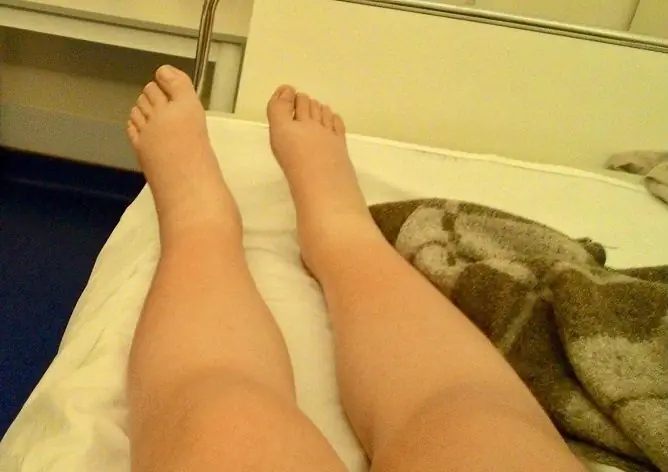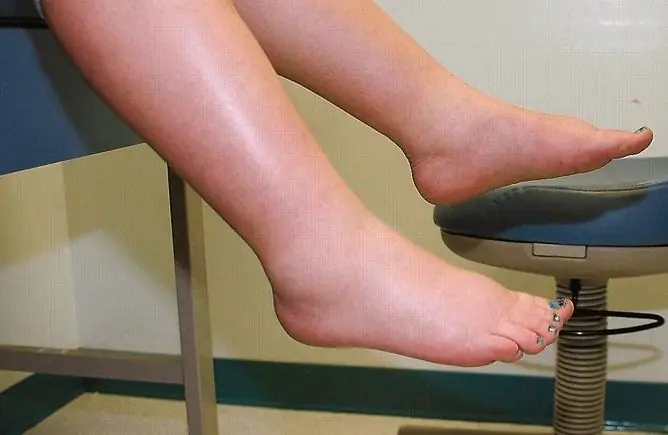- Author Rachel Wainwright [email protected].
- Public 2024-01-15 19:51.
- Last modified 2025-11-02 20:14.
Swelling of the legs after a cesarean section: why it occurs and what to do
The content of the article:
- Why do legs swell after a cesarean?
- Swelling of the legs in the postpartum period
-
What to do if legs swell after cesarean
- Drug therapy
- Physiotherapy
- Foot baths
- Diet correction
- Traditional medicine
- Prevention
- Video
In women, leg edema after a cesarean section occurs quite often and can persist for a long time. The problem may be due to a number of reasons, most of which are associated with the state of the woman's body during the prenatal period.
In most cases, swelling after a cesarean section goes away on its own, without requiring treatment.

After a cesarean section, leg swelling is common, it is rarely associated with pathology, but a doctor's consultation is necessary
Why do legs swell after a cesarean?
Slight swelling of the lower extremities in late pregnancy is due to changes in hormonal levels and difficulty in blood outflow due to compression of blood vessels by an enlarged uterus and is the norm. Usually, in this case, the swelling disappears a few days after delivery, but with delivery by caesarean section, it can persist longer.
Pathological reasons include:
- phlebeurysm;
- kidney pathology;
- heart diseases;
- vein thrombosis of the lower extremities;
- atherosclerotic lesions of the blood vessels;
- endocrine system diseases;
- protein deficiency;
- autoimmune diseases.
Risk factors for puffiness after cesarean are:
- smoking;
- eating foods that promote fluid retention in the body (salty, spicy, fatty foods);
- long-term use of hormonal contraceptives before pregnancy;
- sedentary lifestyle;
- trauma;
- acute respiratory viral infections.
Swelling of the legs in the postpartum period
Edema after childbirth by caesarean section in women can be of varying severity. Sometimes the puffiness is not too noticeable, does not bother the woman, drawing attention to herself only by the fact that the usual worn-out shoes suddenly become tight and uncomfortable. On palpation of the swollen area, a depression forms on the surface of the skin, the tissues do not immediately return to their original state.
With deep vein thrombosis of the lower extremities, massive edema and pain occur. A formidable complication of thrombosis is thromboembolism - the separation and movement of a thrombus through the bloodstream, in this case, a lethal outcome is possible.
With gestosis in women, severe edema is formed not only on the legs, but also on the upper limbs, abdomen, and face.
What to do if legs swell after cesarean
Drug therapy
From medicines, patients can be prescribed diuretics, anticoagulants, anti-inflammatory drugs. If drug therapy is necessary, the choice of drugs for such patients is complicated by the fact that some of the drugs are contraindicated for use during lactation, so only a doctor should select them. It is strongly not recommended to treat pathological edema of the legs on your own.
Physiotherapy
In some cases, the use of physiotherapy methods provides a good effect:
- phonophoresis;
- laser therapy;
- electrophoresis;
- cold wraps.
After childbirth, if swelling of the lower extremities occurs, the patient's condition can return to normal faster when wearing compression stockings or tights, and using an elastic bandage. At home, the patient can also rub the feet, do self-massage.
Foot baths
Foot baths are recommended every day in the evening:
- Contrasting baths. Cold and moderately hot (not higher than 45 ° C) water is poured into two suitable containers, the legs are kept in each of the containers alternately (for 1-2 minutes). You can add infusions or decoctions of medicinal plants (chamomile, oak bark, etc.) or sea salt to the water.
- Salt baths. Add 4 tablespoons of table salt to 5 liters of water at a comfortable warm temperature. The feet should be kept in the saline solution until it cools.

Salt or contrast foot baths can help relieve leg swelling
Diet correction
The diet is recommended to include tomatoes, grapefruits, grapes, lemon, cranberries, dried apricots, sea buckthorn, irga. It is recommended to bake food, stew, steam or boil. Coffee, cocoa, tea, carbonated drinks, fatty, fried, smoked, spicy, salty foods are excluded from the diet.
The table lists some drinks that are generally recommended for women in case of swelling of the lower limbs after childbirth.
| Drink | Explanation |
| Mineral water | Drink water without gas, the amount depends on the need |
| Fruit and berry compotes | The quantity depends on the need |
| Carrot juice | 0.5 cups in the morning before meals |
| Pumpkin juice | 0.5 cups 1 time per day |
| Birch juice | 0.5 cups 2 times a day |
| Mint tea or flax infusion | 1 glass per day |
Traditional medicine
After consulting a doctor, folk remedies can be used as part of therapy:
- Viburnum drink with honey. 2 tablespoons of berries are poured with 1 cup of boiling water and kept in a water bath for 20 minutes, avoiding boiling. The product is allowed to cool, filtered, taken 1/3 cup a day, sweetened with honey.
- Cranberries with honey or sugar. With swelling of the legs, it is useful to use 2-3 tablespoons of cranberries, ground with granulated sugar or honey. They can be put in tea or eaten with a drink.
- Chokeberry juice. Take 1 tablespoon of chokeberry juice (or jam from it) 3 times a day.
- Dried apricot infusion. 200 g of dried apricots are placed in a thermos, 500 ml of boiling water is poured, infused for 6 hours, filtered and taken 0.5 cups 2 times a day.
- Infusion of lingonberry leaves and berries. 2 teaspoons of plant materials are poured with 1 glass of hot water, boiled for 3 minutes from the moment of boiling, removed from heat and insisted under a lid for 15 minutes. Filter the finished infusion and drink 1/3 cup 3 times a day.
- Infusion of chamomile officinalis. 2 tablespoons of chamomile flowers are poured with 1 glass of boiling water, kept in a water bath for 10 minutes, and then infused for 20 minutes under a lid. The product is cooled, filtered and taken in 1/3 cup twice a day.
Prevention
In order to prevent the development of puffiness of the lower extremities after childbirth, even during gestation, it is recommended:
- take walks;
- engage in physiotherapy exercises (after consulting a doctor leading a pregnancy);
- eat properly;
- maintain a healthy weight;
- to refuse from bad habits;
- spend less time in a sitting position (preferably resting while lying down).
Exercises that, in the absence of contraindications, are recommended to be performed regularly can be useful:
- Raise your legs above body level for about 15 minutes (repeat 3-4 times a day).
- When walking, from time to time, try to stand on your toes and walk a few steps in this way.
- From a supine position, make movements with the feet in different directions, bend and unbend the fingers.
- Lying on your back, make movements with your legs that imitate riding a bicycle (you should ask your doctor about when you can start doing this exercise after a cesarean section, this is usually allowed no earlier than a week after the operation).
Video
We offer for viewing a video on the topic of the article.

Anna Aksenova Medical journalist About the author
Education: 2004-2007 "First Kiev Medical College" specialty "Laboratory Diagnostics".
Found a mistake in the text? Select it and press Ctrl + Enter.






